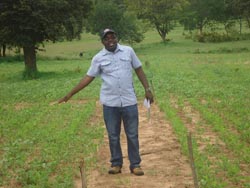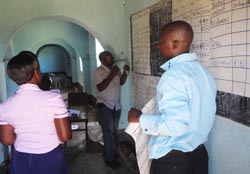Legumes, such as groundnuts, sugar beans, soyabeans, cowpeas and bambara nuts, are important in the cropping systems of smallholder farmers in the communal areas in Zimbabwe. These legumes are often referred to as women’s crops and they are not given as much attention as other crops like maize, tobacco and cotton. Despite the fact that legumes enhance soil fertility through biological nitrogen fixation (BNF), their role in human nutrition and their contribution to household cash income are still not highly appreciated. This article seeks to bring out some challenges that limit the production of the legumes by smallholder farmers in Zimbabwe.
One of the main challenges in the production of legumes is their low yield, which is caused by several factors, such as the use of retained seed, limited availability of proper inputs through agro-dealers, hesitancy of farmers to use phosphorus-based fertilizer, and – particularly for soyabean – the challenges with the availability and use of inoculants.
Farmers are reluctant to buy fertilizer and certified seed. The recycled seed of these legumes has exhausted the production potential and the yields will keep getting lower and lower. As certified legume seeds are in very low demand, many agro-dealers in the country have stopped stocking the legume seeds. Consequently, several seed producing companies have stopped breeding and multiplication of seed of legumes. Furthermore, the seed that is available through seed houses is often of inferior quality which in turn discourages farmers from purchasing seed.
Farmers also lack adequate market information (on desired varieties, prices, etc.) and are not organised to market their crops as groups to enhance their negotiating power for better marketing deals. According to market preferences, some of the varieties grown by farmers are not good enough for processing. For example, groundnuts processors would require small-seeded groundnuts like Natal Common for better quality peanut butter, but most farmers have large seeded groundnuts varieties like Ilanda, Nyanda, Plover, Valencia, Makulu Red which have been circulating among farmers for decades and as a result yield little – on top being not in demand by processors.
Legumes like soyabeans are best grown with inoculants so that their BNF capacity can be enhanced to obtain higher yields. From observations by the N2Africa staff in the areas where the project is being implemented, indications are that most farmers do not know where to get the inoculants. This could be attributed to the way the inoculants are being distributed and sold by the Soil Productivity Research Laboratory (SPRL, a division in the Chemistry and Soils Research Institute (CSRI) under the Ministry of Agriculture, Mechanisation and Irrigation Development (MOAMID)). SPRL is the sole manufacturer of inoculants in Zimbabwe. The inoculants are manufactured and transported for sale to different districts in the country where there is potential for soyabean production. Thereafter, AGRITEX at district level is supposed to sell the inoculants to farmers, making a small profit of USD 0.50 per sachet. However, the district staff is not given any direct incentive as the profit goes to AGRITEX Head Quarters in Harare. In addition, farmers are mostly not aware that the inoculants are to be found at AGRITEX offices. If inoculants were advertised through the national radio, TV programs and in the written press, farmers would know where to get the inoculants. Because of the way in which the inoculants are distributed and marketed, some unscrupulous dealers are now buying the inoculants from SPRL or CSRI and selling them to farmers at inflated prices ranging from USD 10 to USD 15 per sachet, while the gazetted price is USD 5.
 |
 |
|
Isaac Chabata pointing out the different treatments in the soyabean D&D trial of Ambrose Mapire, Makoni district |
Isaac Chabata doing the mid-season Training-of-Trainers in Makoni district |
The Soyabean Promotion Taskforce was successful in increasing soyabean production by smallholder farmers during the late 1990s (Giller et al 2011*). While the importance of inoculants was part of the awareness raising during N2Africa Training-of-Trainers (ToT), some knowledge gaps were noticed among the farmers. In general, most farmers had little knowledge on the functions of inoculants and how they are used. Moreover, some farmers who seemed to have gained knowledge from the work of the taskforce in the 1990s, had erroneous knowledge. For example, a comment from one farmer in Chegutu, when he saw an inoculant sachet being held by N2Africa personnel, was that one could substitute inoculants with brown sugar. Another farmer argued that the inoculants are used to control pests and diseases in the early crop stages of the soyabean crop.
Most smallholder farmers in Zimbabwe do not use fertilizers in the production of legumes, despite the positive results obtained from research. Fertilizer companies in Zimbabwe do not advertise the Phosphorus-based fertilizers for legume production and farmers view the use of legume fertilisers as expensive compared to maize and cash crops.
While most agro-processing companies in Zimbabwe use legumes for processed food and animal feeds, some legume crops still have no lucrative markets in the country. For example, cowpeas are a common legume crop grown in Zimbabwe but there are relatively few output markets for the crop. This may be because cowpea is not a preferred crop in town markets and the crop is usually used for vulnerable feed during times of famines among the poorly endowed families. In addition, cowpea is relatively vulnerable to storage pests after harvest and storage facilities are not accommodative for cowpea.
For all legumes, the main challenge is that processors are interested in buying large quantities. In the case of cowpeas, farmers plant small areas – only to cater for home consumption. As for groundnuts, output markets for the crop exist in the country, but most often smallholder farmers are not yet strongly organized in collective marketing groups and the quantities from individual farmers are too small for lucrative sales.
Lack of credit facilities is also limiting the production of legumes in the country. Some crops are produced under an input-credit facility, for example, cotton, sorghum and tobacco. For legume crops, there is need to find financiers who will bankroll the production of these crops. The processing companies which require the legumes in large quantities could come in and engage in credit schemes with smallholder farmers. This will ease the marketing problem of the legume crops and at the same time promote the production of the desirable varieties for the processing industry. However, it will require farmers to be strongly organized in groups or associations.
Isaac Chabata and Caroline Chipomho
The publication reffered to is: *Giller, K. E., M. S. Murwira, D. K. C. Dhliwayo, P. L. Mafongoya, and S. Mpepereki. 2011. "Soyabeans and sustainable agriculture in southern Africa." International Journal of Agricultural Sustainability 9(1):50–58.
